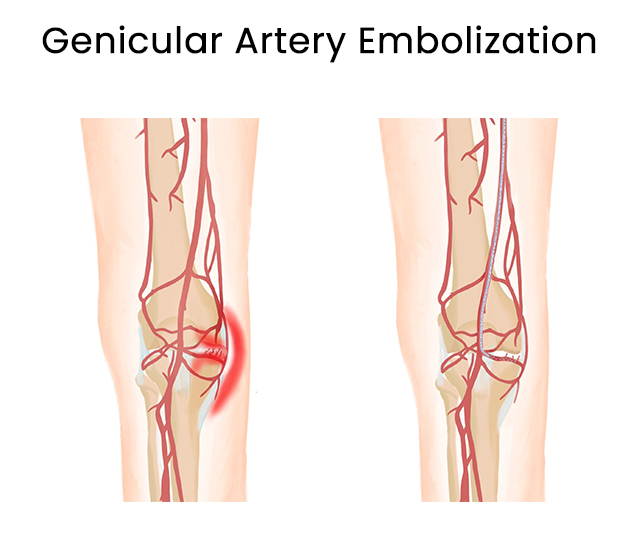Knee osteoarthritis is a wear-and-tear disease, caused by the deterioration of the cartilage in your knee. In osteoarthritis, bones in the joint rub against each other without the shock-absorption normally provided by healthy cartilage. The resulting inflammation leads to pain, swelling, stiffness and a decreased range of motion. Genicular artery embolization is a minimally invasive procedure to treat knee pain caused by osteoarthritis of the knee. When performed by an experience interventional radiologist, this procedure is very effective and safe. At the Downtown Vein & Vascular Center in Brooklyn, Dr. Sergei Sobolevsky has performed over 24,000 image-guided endovascular procedures. Call for an appointment today to relieve your knee pain.
What Is Genicular Artery Embolization?
Genicular artery embolization, also called geniculate artery embolization, is an innovative medical procedure used to treat knee pain due to osteoarthritis. The goal of genicular artery embolization (GAE) is to reduce the flow of blood to the area of inflammation in the joint, which brings pain relief.
Genicular artery embolization involves injecting tiny particles through a small catheter selectively into those specific genicular arteries that supply blood to the areas of inflammation of your knee. The arterial embolization procedure is considered minimally invasive since it is performed via a 2-mm or 3-mm incision.
The success rate of GAE approaches 100 percent with minimal risk of complications, making it safe and effective. As a type of vascular and interventional radiology procedure, performed by an experienced interventional radiology specialist like Dr. Sergei Sobolevsky at the Downtown Vein& Vascular Center. Located in Downtown Brooklyn, this vein and artery specialist serves all of Brooklyn and greater New York City.

What Are the Conditions Treated by Geniculate Artery Embolization?
Genicular or geniculate artery embolization is an image-guided procedure used to treat knee pain from osteoarthritis. During the procedure, your interventional radiologist blocks the blood supply to parts of your knee, leaving the blood supply to the knee tissue intact. You may need this procedure to:
- Reduce pain in your knee
- Improve mobility in your knee
- Reduce swelling in your knee
About 20 percent of all men and women at some point in life report knee pain. The most common cause of a chronic knee pain is osteoarthritis. A geniculate artery embolization aims to treat conditions that include:
- Inflammation in your knee joint caused by osteoarthritis
- Knee pain from overuse or injury
- Swelling of the knee joint due to osteoarthritis
- Damage to the cartilage in your knee joint due to a degenerative disease
When it’s performed by an expert like Dr. Sobolevsky, a GAE procedure carries a relatively low risk of complications and helps relieve your symptoms in the affected area quickly and effectively.
Dr. Sobolevsky was patient and thorough during my vein treatment. He took the time to explain the procedure and what to expect. He was also available to answer any questions I had throughout the process. I would highly recommend him for anyone seeking vein treatment.
Verified Luke D.How Does GAE Work?
Genicular artery embolization is a medical procedure that blocks blood flow to inflamed areas of your knee, reducing pain and swelling. Diagnostic radiology, such as an MRI or x-ray of your knee, helps your doctor assess and locate the affected areas accurately before the procedure. The procedure usually takes between 45 and 90 minutes. Vascular and interventional radiologists who specialize in diagnosing and treating these conditions with minimally invasive techniques perform the procedure.
During a GAE, your genicular arteries are accessed through a small nick in the skin near your hip. The rest of the steps in the GAE process include:
- Your doctor inserts thin tube called a catheter into the artery through a tiny incision.
- Your vascular and interventional radiologist uses dynamic real-time x-ray imaging to locate your genicular arteries.
- Sobolevsky navigates the catheter under image guidance precisely into your genicular artery, which delivers blood to the inflamed tissue in the knee.
- Tiny particles are injected through the catheter. The injected material blocks blood flow to the affected area.
- The procedure is complete when imaging shows that the particles have been successfully placed.
- This procedure prevents nutrients and oxygen from reaching the injured area, which reduces inflammation and pain.
Are There Alternatives to Genicular Artery Embolization?
Symptomatic osteoarthritis of the knee is a progressive, chronic disease. At various stages of osteoarthritis, many treatment strategies may be employed, including:
- Physical therapy, which strengthens the muscles that support your knee joint, reducing your pain and improving the joint’s function
- Oral anti-inflammatory medications — such as non-steroidal anti-inflammatory drugs, opioids or corticosteroids — which help manage your pain, but without addressing its root cause
- Injections of steroids into your knee joint, which reduce pain and inflammation, but can only be given three or four times a year
- Knee replacement surgery, which is a major surgery used when all other treatment methods have been exhausted without relief, plus the longevity of a replaced mechanical knee is limited, so orthopedic surgeons often delay major knee surgery as long as possible
- Geniculate artery embolization, which is an extremely valuable step to take when considering a knee replacement, as it may relieve your symptoms for a long time, delaying or even eliminating the need for joint replacement
If you’re suffering from knee pain and looking for relief, genicular artery embolization may be the correct answer. In the welcoming environment of the Downtown Vein & Vascular Center, you receive an accurate diagnosis and the most effective and appropriate treatment plan for your knee pain. To avoid or delay a knee replacement surgery, contact Dr. Sobolevsky to schedule a consultation. Take the first step toward knee pain relief.
Downtown Vein Treatment Center
480 Court Street, Ste 101
Brooklyn, NY 11231
(718) 787-5559


